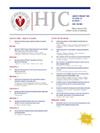Results of systematic patient outcome monitoring: Does post-dilatation during angiography-guided percutaneous coronary intervention improve clinical outcomes?
IF 3
3区 医学
Q2 CARDIAC & CARDIOVASCULAR SYSTEMS
引用次数: 0
Abstract
Objectives
This study evaluates clinical outcomes after implementing a liberal post-dilatation strategy during PCI.
Background
Post-dilatation after percutaneous coronary intervention (PCI) is performed to achieve optimal stent expansion and reduce complications. However, its prognostic effects are unclear and conflicting.
Methods
This study is a pre-post-intervention analysis of two cohorts, before (2015-2017) and after (2018-2020) implementation of a liberal post-dilatation strategy. The primary end point consisted of major adverse cardiovascular events (MACE) at 30 days. Secondary end points consisted of the individual components of the primary end point as well as 1 year mortality and target vessel revascularization.
Results
A total of 10,153 patients were included: 5,383 in the pre-cohort and 4,770 in the post-cohort. The 30-day MACE was 5.00% in the pre-cohort and 4.09% in the post-cohort (p = 0.008; OR 0.75 (CI 0.61-0.93)). There was a significant difference between the pre- and post-cohort in 30-day mortality, respectively, 2.91% and 2.25% (p = .01; OR 0.70 (CI 0.53-0.93)), and MI at 30 days, 1.17% versus 0.59% (p = .003; OR 0.49 (CI 0.31-0.78)). At 1 year, there was a significant difference in mortality between the pre-cohort, 5.84%, and post-cohort, 5.19% (p = .02; OR 0.79 (CI 0.66-0.96)).
Conclusions
A liberal post-dilatation strategy after PCI was associated with a significant decrease in 30-day MACE, 30-day MI, 30-day mortality, and 1-year mortality. Future studies are warranted to validate the causality between post-dilatation and improvement of clinical outcomes.


血管造影引导下经皮冠状动脉介入治疗中扩张后是否能改善临床结果?-系统的患者预后监测结果。
目的:本研究评估PCI期间实施自由扩张策略后的临床结果。背景:经皮冠状动脉介入治疗(PCI)后扩张是为了达到最佳的支架扩张和减少并发症。然而,其预后效果尚不清楚且相互矛盾。方法:本研究对两个队列进行干预前后分析,分别是在(2015-2017)和(2018-2020)实施自由扩张后策略之前和之后。主要终点包括30天的主要不良心血管事件(MACE)。次要终点包括主要终点的各个组成部分,以及1年死亡率和靶血管重建术。结果:共纳入10153例患者;5383人在队列前,4770人在队列后。队列前的30天MACE为5.00%,队列后为4.09% (p=0.008;或0.75 (ci 0.61-0.93))。队列前后30天死亡率差异有统计学意义,分别为2.91%和2.25% (p= 0.01;OR 0.70 (CI 0.53-0.93))和30天的MI分别为1.17%和0.59% (p= 0.003;或0.49 (ci 0.31-0.78))。1年时,队列前的死亡率为5.84%,队列后的死亡率为5.19% (p= 0.02;或0.79 (ci 0.66-0.96))。结论:PCI术后自由扩张策略与30天MACE、30天MI、30天死亡率和1年死亡率显著降低相关。未来的研究有必要验证扩张后与临床结果改善之间的因果关系。
本文章由计算机程序翻译,如有差异,请以英文原文为准。
求助全文
约1分钟内获得全文
求助全文
来源期刊

Hellenic Journal of Cardiology
CARDIAC & CARDIOVASCULAR SYSTEMS-
CiteScore
4.90
自引率
7.30%
发文量
86
审稿时长
56 days
期刊介绍:
The Hellenic Journal of Cardiology (International Edition, ISSN 1109-9666) is the official journal of the Hellenic Society of Cardiology and aims to publish high-quality articles on all aspects of cardiovascular medicine. A primary goal is to publish in each issue a number of original articles related to clinical and basic research. Many of these will be accompanied by invited editorial comments.
Hot topics, such as molecular cardiology, and innovative cardiac imaging and electrophysiological mapping techniques, will appear frequently in the journal in the form of invited expert articles or special reports. The Editorial Committee also attaches great importance to subjects related to continuing medical education, the implementation of guidelines and cost effectiveness in cardiology.
 求助内容:
求助内容: 应助结果提醒方式:
应助结果提醒方式:


